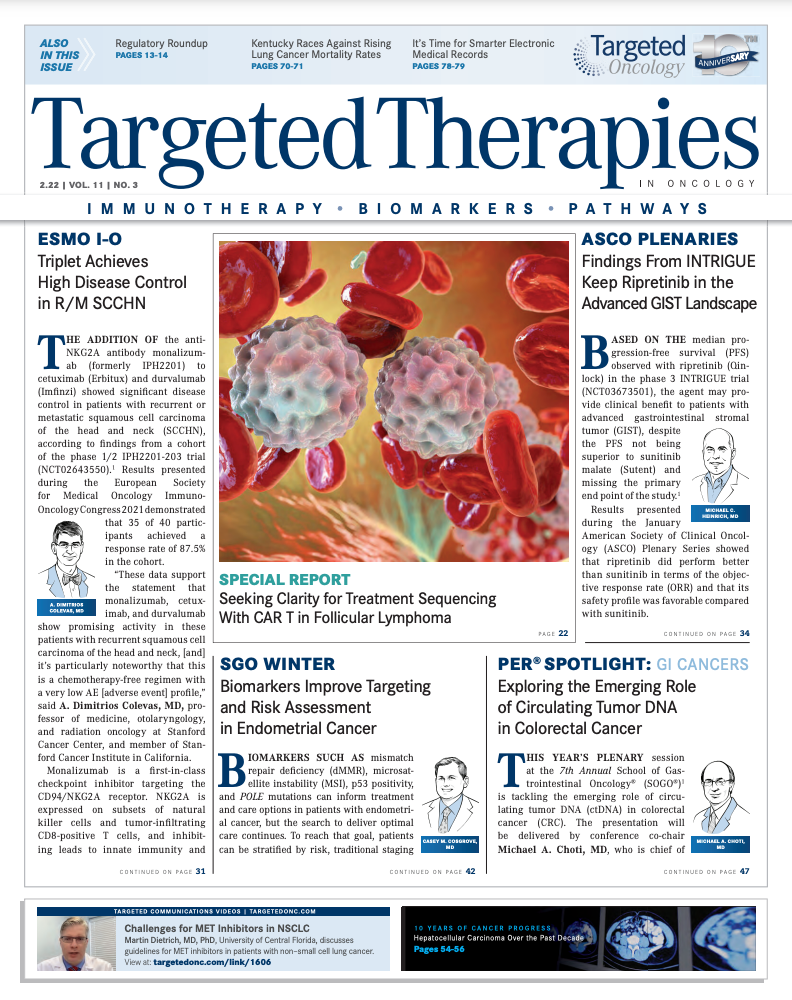PD-L1 Inhibitor TQ-B2450 and Anlotinib Combo Is Promising in Second-Line NSCLC
Positive phase 1 results of TQ-B2450 combined with anlotinib have lead to a phase 3 study of the combination versus pembrolizumab in patient with PD-L1 positive advanced non–small cell lung cancer.

The novel anti-PD-L1 ntibody TQ-B2450 in combination with anlotinib, a multitargeting tyrosine kinase inhibitor, led to an improvement in efficacy over immunotherapy alone in previously treated patients with advanced non-small cell lung cancer (NSCLC), according to results from a double-blind, randomized phase 1 trial (NCT03910127) presented during the European Society for Medical Oncology Immuno-Oncology Congress 2021. “PFS [progression-free survival] and ORR [objec- tive response rate] with TQ-B2450 combined with anlotinib were significantly improved compared with the control group [in patients with advanced NSCLC],” said Baohui Han, MD, PhD, professor of respiratory medicine at Shanghai Chest Hospital of Shanghai Jiao Tong University in China. “TQ-B2450 combined with anlotinib may be a promising treatment for advanced NSCLC.”
Enrolled patients had stage IIIB-IV NSCLC, an ECOG performance status of 0 or 1, and received at least 1 line of chemo- therapy but had failed or were intolerant to treatment. Additionally, patients were EGFR and ALK wild type and were not restricted by PD-L1 tumor proportion score (TPS) levels.
A total of 101 patients were randomized equally between 3 treatment arms: TQ-B2450 at 1200 mg intravenously (IV) on day 1 of each 21-day cycle plus anlotinib at 12 mg daily on days 1 to 14 of the cycle, TQ-B2450 at 1200 mg IV and anlotinib at 10 mg daily, or TQ-B2450 at 1200 mg IV plus placebo. Treatment continued until progressive disease or intolerance to treatment. However, the 2 doublet arms were later combined (n=68) and compared with the monotherapy arm (n = 33), as the average daily exposed dose of anlotinib was 10.2 mg.
The primary end point was PFS, and sec- ondary end points included safety, ORR, disease control rate (DCR), duration of response (DOR), and overall survival.
In the merged combination arm, the median age was 61.5 years (range, 30-73), 69.12% were men, 95.59% had an ECOG performance status of 1, and 60.29% were former smokers. The most common pathology was adenocarcinoma in 63.24% of patients followed by squamous cell carcinoma in 20.59%, but was unknown in 16.18%. Most patients had stage IV disease (80.88%), no brain metastases (86.67%), and positive PD-L1 expression (88.37%).
In the monotherapy arm, the median age was 60 years (range, 47-77), 81.82% were men, 93.94% had an ECOG performance status of 1, and 66.67% were former smokers. A total of 63.64% of patients had adenocarcinoma vs squamous cell carcinoma pathology in 27.27%, and 82.76% had stage IV disease. Brain metas- tases were reported in 27.27%, and 79.27% had positive PD-L1 TPS of 1% or higher.
At a median follow-up of 11.1 months, the median PFS with the combination of TQ-B2450 and anlotinib was 6.9 months (95% CI, 5.3-12.4) vs 2.7 months (95% CI, 1.4-4.7) with TQ-B2450 alone (HR, 0.43; 95% CI, 0.25-0.73; P = .0014). Across prespecified subgroups, PFS favored the doublet arm, except in currently smoking patients (HR, 1.09; 95% CI, 0.20-6.05).
In the combination arm, the ORR was 30.9% (95% CI, 20.2%-43.3%), consisting of all partial responses. Stable disease (SD) was achieved by 42.6% of patients, resulting in a DCR of 73.5% (95% CI, 61.4%-83.5%). In the monotherapy arm, the ORR was 3.0% (95% CI, 0.1%-15.8%), and 51.5% achieved SD, for a DCR of 54.6% (95% CI, 36.4%-71.9%). The difference between the 2 arms in response was 27.9 percentage points (P = .0043) and 18.9 percentage points for dis- ease control (P = .1620). The median DOR in the combination arm was 16.6 months and was not evaluable in the monotherapy arm (P = .8195).
Adverse events (AEs) were reported in all patients in the combination arm and in all but 2 in the monotherapy arm. In the doublet arm, 92.65% of events were considered TQ-B2450 related and 94.12% were considered related to anlotinib. Grade 3 or higher treatment-emer- gent AEs were reported in 67.65% and serious AEs in 41.18%. Anlotinib dosing was disrupted in 33.82% of patients, adjusted in 22.06%, and discontinued in 20.59%. In the monotherapy arm, 84.85% of patients had treatment-related AEs, grade 3 or higher events were reported in 21.21%, and serious AEs in 15.15%.
The most common treatment-related AEs of any grade in the combination arm were hypertension (48.53%), hypertriglyceridemia (42.65%), increased aspartate aminotrans- ferase levels (35.29%), increased thyroid- stimulating hormone levels (35.29%), and increased alanine aminotransferase (ALT) levels (32.35%). Common grade 3/4 AEs with the doublet included hypertension (19.12%) and hypertriglyceridemia (8.82%).
With single-agent TQ-B2450, the most com- mon treatment-related events of any grade were anemia (24.24%), hyperglycemia (24.24%), increased ALT levels (21.21%), and loss of appe- tite (18.18%). Only 1 grade 3/4 was reported in the monotherapy arm of hypertension.
Han noted that a randomized, controlled phase 3 trial (NCT04964479) is ongoing, exploring the combination of TQ-B2450 and anlotinib vs pembrolizumab (Keytruda) in the treatment of patients with advanced NSCLC and positive PD-L1 expression.
REFERENCE
Han B, Li K, Wang Q, Cheng Y, Yang L, Li Y. The efficacy and safe- ty of TQ-B2450 alone/with anlotinib in previously treated advanced non-small cell lung cancer (NSCLC): a multicenter, randomized, dou- ble-blind clinical trial. Presented at: ESMO Immuno-Oncology Con- gress 2021; December 8-11, 2021; virtual. Abstract LBA4.
